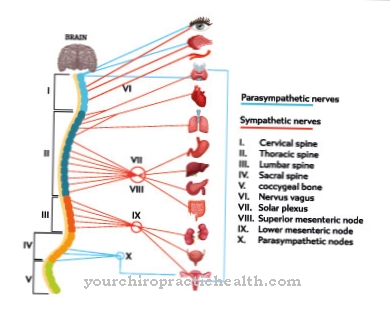AIDS, derived from Acquired Immune Deficiency Syndrome, is an immunodeficiency disease caused by the HI virus. The AIDS disease is therefore preceded by HIV infection. Unfortunately, as of the current state of medical research, there is still no cure or therapeutic approach that can successfully treat this disease. The most common cause of infection with HI viruses and subsequently AIDS is unprotected sexual intercourse with people who have already been infected with HI viruses.
What is AIDS

The disease AIDS (abbreviation for: Acquired Immune Deficiency Syndrome, which in German roughly means: acquired immunodeficiency syndrome) is now known to everyone, because it is incurable to this day and can shorten life considerably. It is often confused with HIV infection, in which only the HI virus has infected the human body and will ensure that the immune system is completely destroyed over a period of several years.
AIDS, on the other hand, describes the condition in which the immune system is so severely destroyed that so-called opportunistic infections can spread and ultimately kill people.
causes
AIDS is the terminal consequence of infection with the HI virus. As soon as the viruses find their way into the human body, they initially only trigger mild, flu-like symptoms, which soon go away. The viruses do not do this, however: They remain in the body and cannot be recognized and destroyed by human immune cells, as would be the case with other pathogens.
Viruses smuggle their RNA (ribonucleic acid) into healthy human body cells and reprogram them in such a way that they can only produce new viruses. Then the body cells die and the viruses look for new host cells again. This mechanism destroys healthy immune cells until finally none are left.
One speaks of AIDS when the state of the immune system is obviously permanently disturbed or sick. AIDS makes itself felt through so-called opportunistic infections or opportunistic tumors, which can spread because the immune system has nothing to counter them.
Symptoms, ailments & signs
As a full picture of an HIV infection, AIDS is characterized by severe opportunistic infections, functional disorders of the brain and the so-called wasting syndrome. The wasting syndrome results in long-lasting diarrhea, fever, fatigue and severe weight loss that exceeds ten percent of body weight. The functional disorders of the brain manifest themselves through a variety of neuropsychiatric symptoms such as impaired consciousness, movement disorders and vegetative disorders.
Degenerative processes can lead to increasing dementia. Particularly typical of AIDS, however, are the severe opportunistic infections that are triggered by microorganisms, which do not cause problems in healthy people. These infections include severe pneumonia caused by the fungus Pneumocystis jirovecii, bacterial pneumonia, tuberculosis, toxoplasmosis or repeated infections with salmonella.
Herpes infections in the stomach, esophagus or lungs are also common. Furthermore, infections occur that do not even occur in healthy people. These include infections with the cytomegalovirus, which particularly attacks the retina of the eye, fungal infections transmitted by birds, intestinal infections with single cells and other atypical infections.
Typical of AIDS is the occurrence of malignant tumors such as Kaposi's sarcoma, various non-Hodgkin lymphomas, malignant tumors of the CNS or aggressive cervical cancer. Kaposi's sarcoma is characterized by multiple brown-red hardened plaques on the skin. These lumps form ulcers and, if left untreated, can affect the entire skin, mucous membranes, and various organs. Every single illness that occurs in the context of AIDS can lead to death.
course
The course of the disease in AIDS takes very little time. After all, AIDS is only mentioned as soon as the immune system is no longer able to fight off other pathogens. The course of the disease is structured in such a way that one day the person affected gets sick with an infection that can be trivial - however, he will die from this within a few weeks, as the HI infection has almost completely weakened his immune system. Tumor diseases that can quickly lead to death are also possible.
Before AIDS can occur, however, the HI infection is followed by a period of latency for years, during which the immune system is simply broken down. Meanwhile, the person affected may not die from common infections, but they can last longer and become more difficult. Only when it becomes obvious that the person affected can no longer defend himself against an illness can we speak of AIDS.
Very rarely it can also happen that AIDS never breaks out and the infected person remains in the latency phase for life or fights the HI virus.
Complications
As the end-stage of HIV infection, AIDS is always associated with serious complications. First, there is an increased risk of various infections and inflammations, including, for example, bronchitis, cytomegaly, salmonella septicemia and the candida fungal infection. Pneumonia or inflammation of the esophagus and various types of pneumonia are also common.
The risk of tumor diseases also increases significantly, which can cause cervical cancer and malignant lymphoma, among other things. Specific sequelae of AIDS are Kaposi's sarcoma (a malignant tumor), wasting syndrome (rapid weight loss with chronic diarrhea) and mycobacterial infections, which occur either in the lungs or throughout the body.
In general, there is an increased risk of developing tumors and infections with AIDS. The occurrence of these secondary diseases is usually accompanied by rapid physical and mental decline. Diseases such as HIV encephalopathy cause irreversible damage to the brain and thus lead to further complications.
Ultimately, AIDS leads to multiple organ failure and unconsciousness, along with the death of the patient. Comprehensive therapy can at least reduce typical AIDS complications these days.
When should you go to the doctor?
After a certain incubation period (which can take a long time), infection with HIV leads to AIDS. The tricky thing is that the first symptoms after being infected with the flu or a flu-like infection are similar and initially cannot be easily distinguished from them. The symptoms are diffuse symptoms such as fever, fatigue, headache, loss of appetite, rash, muscle pain, nausea, diarrhea or weight loss. For this reason, infection with the HI virus is often not immediately recognized as such.
Another problem is that the symptoms that follow after infection are followed by a longer latency period that can last for years. During this time, patients are practically symptom-free. However, if the infection with HIV is not treated, this inevitably leads to the onset of the disease at a later point in time. A severely weakened immune system is the most important characteristic. It makes those affected susceptible to infections and cancer.
So if flu-like symptoms occur for no apparent reason, which persist over a long period of time and where conventional treatment methods do not work, it is time to see a general practitioner. They can do a blood test and then refer them to special specialists. This is especially true if you belong to the so-called risk groups (drug addicts, people with frequently changing sex partners, etc.)
Doctors & therapists in your area
Treatment & Therapy
AIDS cannot currently be cured, only palliative treatment is possible. As soon as the person concerned becomes ill with an opportunistic infection, it is possible to at least alleviate the symptoms. If you have a cold or similar infection from AIDS, symptoms can be combated. Treatment with antibiotics or other means would no longer make sense.
However, the main focus of the treatment of AIDS at present is to delay the onset of AIDS after an HIV infection. There are already modern approaches that this delay is possible for several years or even decades. However, medical research is working flat out to defeat AIDS.
If, on the other hand, it is an opportunistic tumor caused by AIDS, pain medication is often administered and the person affected suffers less as a result. It is also important to monitor the AIDS patient during this time in order to be able to treat symptomatically appropriately and to avoid pain.
Outlook & forecast
An HIV infection is still not completely curable. A fully developed immune deficiency can, however, be avoided through comprehensive therapy. Consistent and permanent treatment of the virus infection is crucial for a positive prognosis.
However, once AIDS has broken out, it is fatal. Modern drugs can nevertheless significantly improve the life expectancy and quality of life of those affected. In the long term, however, secondary diseases such as infections and liver or cancer diseases develop, which continue to weaken the immune system and the entire organism.
Patients with other illnesses as well as the elderly or drug addicts have a particularly low life expectancy. Even in countries with less good health care, the prospects for a long life with AIDS are much worse.
Aftercare
There are no aftercare measures that can be taken in the case of AIDS. Rather, the follow-up measures must be based on the various ailments that result in the diagnosis of "AIDS". The reason for this is that AIDS cannot be cured. In some cases, however, the condition of the patient can still be improved through consistent drug therapy. Follow-up examinations consist of monitoring CD4 levels and viral load everywhere.
For HIV-associated anal cancer, annual check-ups are required, which consist of checking the rectum and parts of the colon. For all infections and parasite infestations associated with HIV, the appropriate follow-up options must also be exhausted. In many cases, this means regular medical care for the AIDS patient as well as checking the blood values in order to detect and monitor subsequent infections.
Overall, the follow-up measures that are taken in AIDS patients in the event of diseases occurring and treated are the same as in HIV-negative patients. Only the use of immunosuppressants (where this makes sense) should be urgently reconsidered.
To prevent further opportunistic infections, those affected by AIDS should live a very healthy lifestyle that strengthens the immune system as much as possible. This includes a healthy diet, exercise and the avoidance of substances that have a negative effect on the immune system - such as alcohol and nicotine.
You can do that yourself
Since AIDS is an acquired immune deficiency, all steps that strengthen the immune system are indicated. Due to the severity of the disease, self-help measures are only possible to a limited extent.
In addition to regular medication, a vitamin-rich mixed diet, lots of sport and exercise in the fresh air are beneficial. It is important to ensure that there is a sufficient amount of vitamin C. Other immune-boosting measures such as alternating showers and a regular daily routine are also helpful. In part, this can reduce the side effects of the medication. Those who maintain a positive outlook on life despite the disease are also good for their immune system. Helpful, supportive social contacts instead of exclusion are beneficial for body, soul and spirit.
Because of their immune deficiency, those affected should avoid infections from others. Vaccinations can help (for example when traveling to other countries), but vaccinations are sometimes discouraged for AIDS sufferers. Alternative healing methods can be tested as supportive measures. However, acupuncture, homeopathy and the like are not yet scientifically founded.




.jpg)

.jpg)

















.jpg)



